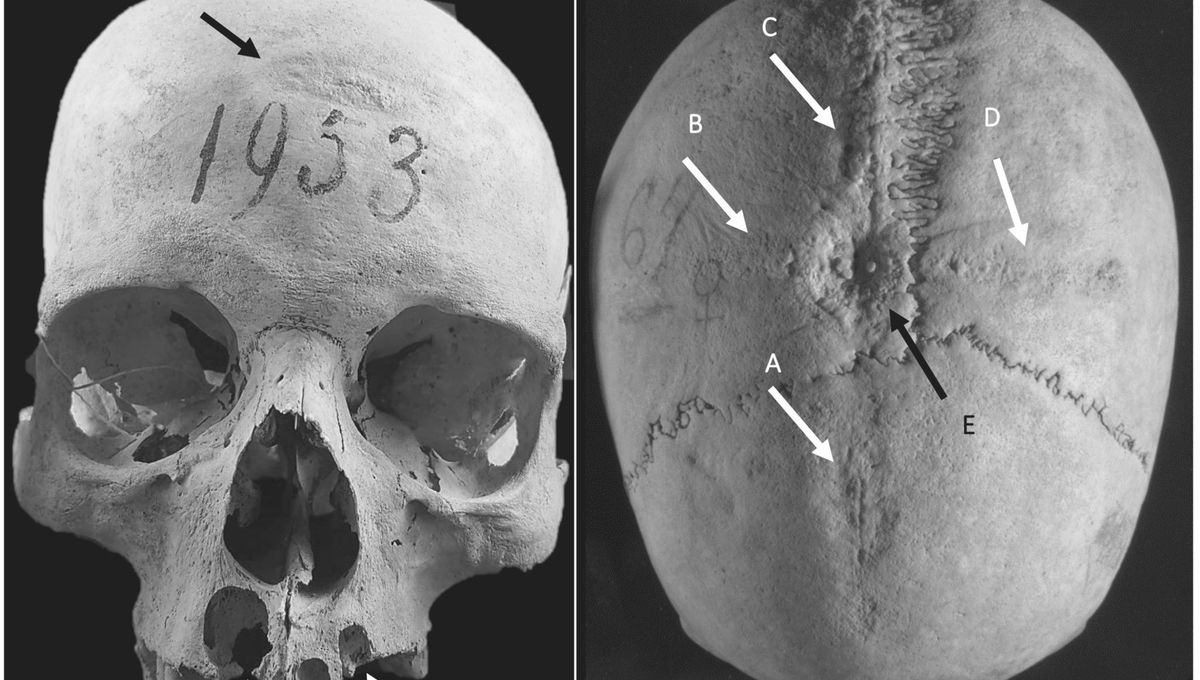
A skull belonging to a Byzantine-era woman in central Italy displays signs of having been surgically fiddled with on at least two separate occasions. Reporting the find in a new study, researchers say the unenviable patient probably underwent a series of trepanations in order to treat a “systemic pathological condition,” although they can’t say exactly what was wrong with her or if the surgeries had any positive effect.
The cranium was recovered from the Lombard necropolis of Castel Trosino, which acted as a burial ground between the sixth and eighth centuries. Following the fall of the Roman Empire, the site became a strategic Byzantine stronghold and was inhabited by some of the wealthiest Lombard families.
Excavations at Castel Trosino have turned up lavish grave goods including gold and fine jewelry, yet the study authors say their surprising new discovery represents “the first evidence of a cross-shaped bone modification on a living subject.”
Apparently made using a sharp-edged metal scraping tool, the cross contains a rounded area of well-healed bone at its center. According to the researchers, such healing usually takes around six months to occur after an injury, suggesting the woman survived the procedure.
However, a second set of “V-shaped marks” show no such healing, which means the woman probably died very soon after this second operation. Whether or not she perished as a direct result of this cranial surgery is unclear, though.
“We found that the woman had survived several surgeries, having undergone long-term surgical therapy, which consisted of a series of successive drillings,” explained study author Ileana Micarelli in a statement. “The last surgery seems to have taken place shortly before the death of the individual,” adds co-author Giorgio Manzi.
That skull scrapings of this sort had never previously been seen at the site led the researchers to question their origin and purpose. For instance, noting that ritualistic trepanation was practiced by the Avar people who inhabited the Carpathian basin during the same historical period, the study authors wondered whether the marks displayed on the woman’s skull may have been symbolic in nature. However, this hypothesis was eventually dismissed as there is no archaeological evidence to support ritualistic trepanation at Castel Trosino.
The researchers also considered whether the markings could have been left by a brutal form of judicial punishment known as decalvatio, which involves mutilation by scalping. However, records suggest that this rare and dishonorable penalty was only applied to soldiers who deserted the battlefield or those who traded without a license. Furthermore, the shape and distribution of the woman’s skull markings don’t match those associated with decalvatio, which was therefore dismissed as a possible cause.
A medical explanation was ultimately determined to be the most likely, despite the fact that the researchers found no direct evidence of “trauma, tumor, congenital disorder, or other pathology.”
“However, the presence of porosity on the skull surface and the lesion on the ectocranial surface suggests a systemic pathological condition,” write the study authors. After analyzing texts from the first, seventh and 12th centuries, the researchers note that cross-shaped trepanations were common procedures in antiquity, further supporting the idea that the markings were derived from some sort of surgery.
“This represents one of the few pieces of archeological evidence of a trepanation surgery performed on Early Medieval women paving the path for future research on the rationale behind this dangerous surgical procedure in this period,” conclude the authors.
The study has been published in the International Journal of Osteoarchaeology.
Source Link: Medieval Italian Woman Had Her Skull Operated On Multiple Times